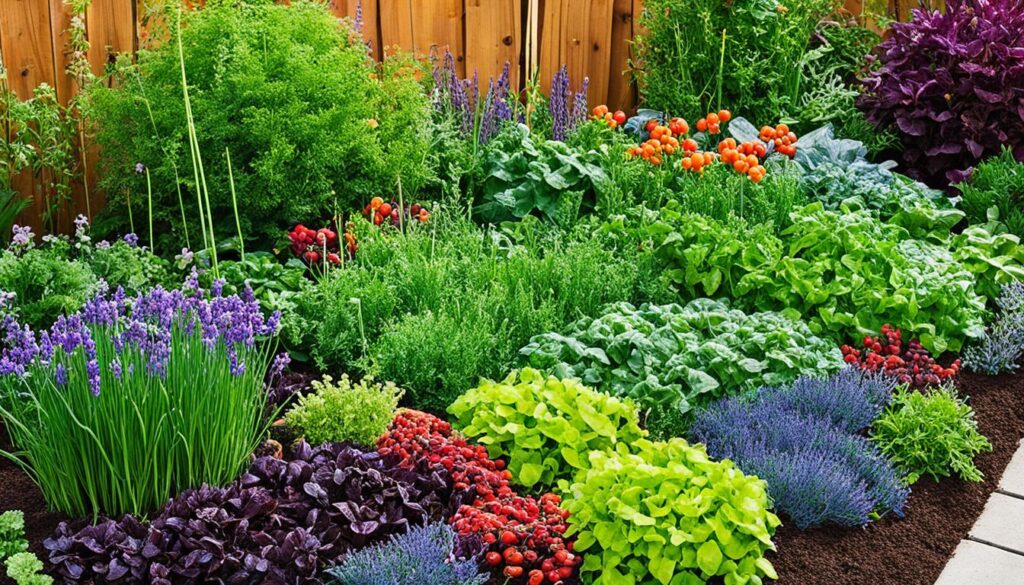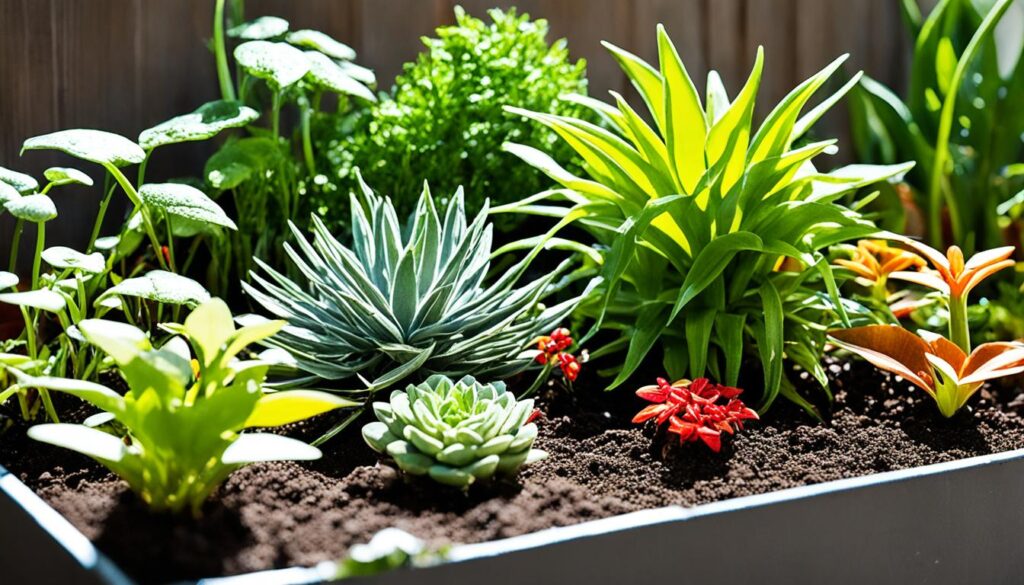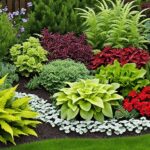Companion Planting in Small Spaces
Having a backyard garden is rewarding. It gives you fresh produce, lowers stress, and makes your outdoor area look great. But, if your small garden is tight, you can still boost your gardening with companion planting. This guide will show you how companion planting in small spaces works, help you pick the right plants, and give tips for your compact garden.
Imagine turning your small backyard or balcony into a lush, productive spot. By learning about companion planting, you can find the best efficient plant pairings. This way, you can create a balanced small space gardening setup, even in busy urban gardening areas. Ready to learn more about container companion planting? Let’s get started.
Key Takeaways
- Companion planting can maximize limited space in small gardens or containers
- The right plant pairings can deter pests and enrich the soil
- Vertical gardening techniques like trellises and hanging baskets can boost productivity
- Interplanting and succession planting strategies can provide a continuous harvest
- Careful plant selection and spacing considerations are key for small space gardening
The Benefits of Companion Planting in Small Spaces
Companion planting in small spaces is great for gardeners with limited space. By pairing plants wisely, you make the most of every inch in your garden. Each plant helps the others grow and thrive, keeping pests away and making the soil healthier.
Efficient Use of Limited Space
With companion planting, plants work together in harmony. Some plants act as a natural mulch, keeping the soil cool and moist. Others grow upwards, making the most of your space. This way, you can grow many plants in a small area, giving you a big harvest from a little garden.
Pest Deterrence and Soil Enrichment
Companion plants are key to keeping pests away and improving soil health. Some plants naturally keep pests off your crops. Others fix nitrogen in the soil or attract good insects, keeping your garden balanced and healthy. This means you use fewer chemicals and have a better garden.
Using companion planting in your small garden makes it both productive and sustainable. With smart plant choices, you can fight pests and improve your soil. Enjoy a beautiful, thriving garden that uses space well and is good for the planet.
Choosing Suitable Plants for Companion Planting
Choosing the right plants for a small-space garden is key. Look for plants that are small but still produce well together. Breeders are always coming up with new compact plant varieties for urban gardening and small space plant selection. This makes it easier to pick the perfect plants for your garden.
Think about the plants you like or buy often. Use those in your garden plans. This way, you’ll get a good harvest and use your space well.
| Compact Vegetable Varieties | Compact Herb Varieties | Compact Flower Varieties |
|---|---|---|
| Bush Beans | Dwarf Basil | Marigolds |
| Patio Tomatoes | Compact Thyme | Nasturtiums |
| Miniature Eggplants | Dwarf Rosemary | Petunias |
With the right small space plant selection, you can make a garden that’s both beautiful and efficient. Companion planting helps you use your space well.
Vertical Gardening Techniques
Vertical gardening techniques are a big help when you have little garden space. You can use trellises, cages, and hanging baskets to grow plants like cucumbers, tomatoes, and pole beans up high. This saves ground space for other plants. Living walls and herb towers are great for small gardens too. They let you grow many herbs and greens in a small, vertical space.
Trellises, Cages, and Hanging Baskets
Trellises, cages, and hanging baskets are great for making the most of your vertical space. They support plants that grow up, saving ground space for other plants. You can also make your garden look beautiful and work well by adding these vertical elements to your design.
Living Walls and Herb Towers
For a really compact way to garden vertically, think about a living wall or an herb tower. These systems let you grow many plants, from leafy greens to herbs, in a small area. Living walls are perfect for a lush look on a wall or fence. Herb towers are a smart way to keep your favorite herbs close by.
“Vertical gardening techniques are a game-changer for small-space gardeners, allowing you to maximize your growing potential and create visually stunning displays.”
Interplanting and Intercropping Strategies
Using interplanting and intercropping can make your small garden work harder. These methods boost productivity and create a healthier garden. They make your garden more vibrant and full of life.
Pairing Plants with Complementary Growth Habits
For interplanting to work, pair fast-growing plants with slower ones. Plant quick veggies like radishes or lettuce among bigger plants like broccoli or peppers. This way, you can pick the quick plants early, without hurting the growth of the bigger ones.
Intercropping means mixing plants that grow well together. For example, put shallow-rooted veggies with deep-rooted ones. This reduces competition for water and nutrients. Each plant gets what it needs without taking too much space. This method makes your garden more efficient and full of food.
| Interplanting | Intercropping |
|---|---|
| Planting fast-growing crops between slower-growing plants | Pairing plants with complementary growth habits |
| Allows you to harvest quick-maturing crops before larger plants need more space | Minimizes competition for resources and maximizes space utilization |
| Examples: Radishes or lettuce between broccoli or peppers | Examples: Shallow-rooted veggies with deep-rooted ones |
Learning interplanting and intercropping can turn your small garden into a productive spot. You’ll get lots of fresh, healthy food in a small space.
Succession Planting for Continual Harvest
Learning succession planting is a big win for gardeners with limited space. This method keeps your garden full of fresh food all season. It makes the most of every inch of your garden.
Succession planting means having seedlings ready to go when you harvest the first crop. By planting quick-growing veggies like radishes, salad greens, and peas at different times, you get a steady supply of fresh food. This way, you can enjoy homegrown produce from spring to fall.
In small gardens, every bit of space counts. With careful planning and knowing how fast different plants grow, you can make the most of your space. This means a constant flow of fresh produce from your garden.
“Succession planting allows me to make the most out of my limited gardening space. By having seedlings ready to go as soon as one crop is done, I can keep my garden in constant production and enjoy a steady supply of fresh produce all season long.”
Whether you’re an experienced gardener or a beginner, adding succession planting to your garden plan is a smart move. It helps you grow more food for longer and keeps your garden busy all season.
Succession planting is a key strategy for gardeners with limited space. It lets you use your garden space well and enjoy a steady harvest all season.
Companion Planting in Small Spaces
Companion planting is key for a successful garden in small spaces. By pairing plants wisely, gardeners can use space well, keep pests away, and improve soil quality.
Recommended Plant Combinations
Some top pairings for small gardens include:
- Planting shade-tolerant crops like lettuce and basil with taller plants like tomatoes to use space well.
- Combining flowering plants like marigolds and nasturtiums with vegetables to draw in good bugs and keep pests away.
- Pairing plants that fix nitrogen like legumes with heavy eaters like peppers or corn to boost soil health.
Spacing and Soil Considerations
When planning your garden, think about how much space and soil each plant needs. Good spacing lets each plant get what it needs to grow well. High-quality soil is key for a successful garden.
| Plant | Spacing | Soil Needs |
|---|---|---|
| Tomatoes | 18-24 inches | Well-draining, nutrient-rich |
| Lettuce | 6-12 inches | Moist, nutrient-rich |
| Basil | 12-18 inches | Moist, well-draining |
By thinking about these things, gardeners can make a great companion planting system. This makes the most of small spaces.

“Companion planting is a time-honored tradition that can work wonders in small-space gardens, helping to create a more diverse, productive, and pest-resistant growing environment.”
Container Gardening for Small Spaces
If you’re short on outdoor space, container gardening can change the game for your small space gardening efforts. This method lets you grow a variety of plants, from bright flowers to patio gardening and balcony gardening crops, easily.
Choosing the Right Containers
When picking containers for your container gardening, think about what your plants need. Big, deep pots are great for climbing plants and larger plants. Smaller pots are better for herbs, greens, and smaller vegetables.
- Look for pots with good drainage to prevent waterlogging and ensure healthy root growth.
- Choose materials that suit your climate, such as terracotta for hot, dry regions or plastic for cooler climates.
- Opt for self-watering containers to simplify your gardening routine and reduce the risk of over- or under-watering.
| Container Size | Suitable Plants |
|---|---|
| 5-10 gallons | Tomatoes, peppers, eggplants, bush beans, dwarf fruit trees |
| 2-5 gallons | Herbs, leafy greens, radishes, carrots, compact vegetable varieties |
| 1-2 gallons | Herbs, strawberries, small lettuce varieties, microgreens |
By picking the right containers for your small space gardening, you can make the most of your space. You’ll enjoy a full harvest, even in tiny outdoor areas.
Maximizing Light and Soil Quality
In small space gardening, getting your plants the right light and soil is key. They need enough light and nutrient-rich soil to grow well. This is vital for a successful urban garden or small space garden.
Place your plants where they get the right amount of sunlight. Most veggies and herbs do best with lots of small space garden lighting. If the sun isn’t enough, add artificial lights to help your plants.
Soil quality is also crucial. Use soil that’s full of nutrients and drains well to help your plants grow strong. Soil health affects how tasty your food is and how much you’ll get. So, make sure to create the best soil for your urban gardening projects.
Soil Preparation Tips
- Conduct a soil test to identify any nutrient deficiencies
- Amend the soil with organic matter, such as compost or aged manure
- Ensure proper drainage by incorporating sand or perlite, if needed
- Maintain the optimal pH range for your chosen plants
| Vegetable | Ideal Soil pH |
|---|---|
| Tomatoes | 6.0 – 6.8 |
| Carrots | 6.0 – 6.5 |
| Lettuce | 6.0 – 7.0 |
By making sure your plants get enough light and have healthy soil, you can make your small space garden lighting and urban gardening thrive. This means a bigger and better harvest.

“The key to a successful small-space garden is understanding the unique needs of your plants and providing them with the necessary resources to thrive.”
Conclusion
Using small space gardening and companion planting can turn even tiny outdoor spots into a lush, productive garden. You can make the most of your space by planning where plants go and what they need. This way, you get a lot of fresh, homegrown food.
This article shares tips like vertical gardening and planting together to help urban gardeners use their space well. By picking plants that work well together and arranging them smartly, you can make a garden that looks good and grows food without pests. It also makes the soil better and keeps you eating fresh, healthy food all year.
Start with companion planting to make your small space gardening dreams come true. With some creativity and hard work, you can have a lovely, full garden right in your city.
FAQ
What are the benefits of companion planting in small spaces?
How do I choose suitable plants for companion planting in a small garden?
What vertical gardening techniques can I use in a small space?
How can interplanting and intercropping strategies benefit my small garden?
How can succession planting help me extend my small garden’s productivity?
What are some recommended plant combinations for companion planting in small spaces?
How can container gardening benefit my small-space companion planting setup?
What factors should I consider to maximize light and soil quality in my small garden?
Source Links
- 10 Must-Have Blooms for Your 2025 Garden
- The Health Advantages of Gardening You Need to Know
- How to Create a Small Vegetable Garden Layout Plan: A Beginner’s Guide
- DIY Garden Projects for Small Spaces: Upcycling Ideas to Maximize Your Garden
- Watering Techniques for Small Gardens: Ensuring Your Plants Thrive
- Small Border Plants for Landscaping: Adding Beauty and Functionality to Your Garden
- Year-Round Small Space Gardening: Seasonal Planting Tips for Maximum Harvest
- Essential Tools for Small-Space Gardening: What You Really Need
- The Ultimate Guide to Container Vegetables: What to Grow in Small Spaces
- Budget-Friendly Gardening: How to Create a Thriving Garden on a Tight Budget
- How to Optimize Sunlight in Small Gardens: Tips for Better Plant Growth
- DIY Vertical Planters: Creative Ideas for Small Space Gardening
- Companion Planting for Small Vegetable Gardens: Boost Growth and Deter Pests
- Container Gardening Essentials: Choosing the Right Pots, Soil, and Plants
- Vertical Gardening Techniques: Maximizing Your Small Space with Climbers and Vines
- How to Build a Raised Bed Garden in a Small Backyard: Step-by-Step Guide
- The Best Vegetables for Small-Space Gardens: High-Yield Varieties You Need to Grow
- Smart Vegetable Garden Layouts for Small Spaces: Maximizing Your Green Thumb in Compact Areas
- 40. Best Practices for Managing a Sustainable Garden Year-Round
- Building a Wildlife Pond for Biodiversity
- Advanced Techniques in Sustainable Gardening
- How to Create a No-Till Garden
- The Mental Health Benefits of Gardening
- Using Technology to Enhance Sustainable Gardening
- Getting Certified Organic: Steps and Benefits

Leave a Reply